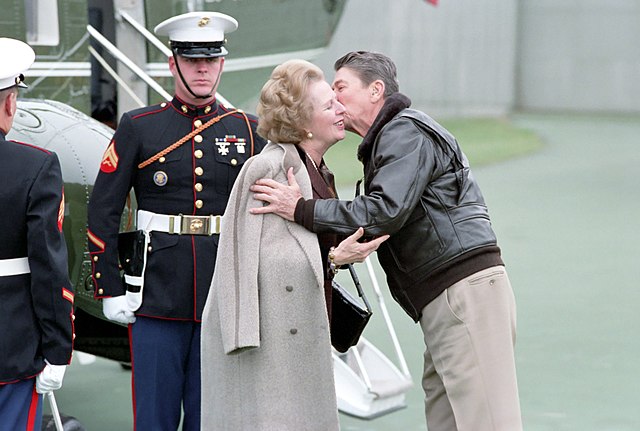The History and Understanding of Political Liberalism
September 11th 2023
1500 words

Intro
Liberalism is considered the school of thought that acts as the foil against realism. After Realism, Liberalism is the most popular school of thought for international politics. While Realism is the pessimistic view of the world, Liberalism gives a more optimistic view. It is a political view filled with hope. In a previous post, I looked at Realism. In this post, I will give a summation of Liberalism. In future posts, I will take a look at other schools of thought, mainly Constructivism and Marxism.Origins of Liberalism
The beginnings of Liberalism have its beginnings in the enlightenment around the late 17th century and 18th century. Some of the main developers of political Liberalism are Voltaire, John Locke, Adam Smith, and Immanuel Kant. The main two thinkers that I want to shed a light on are John Locke and Immanuel Kant. The first thing to understand about these thinkers is that they were influenced by the 30 Years' War. From the aftermath of this war, these philosophical thinkers came to the conclusion that people were inherently against war. Also, they believed that people were born with inherent rights that government is meant to protect. It is these two beliefs that unites their philosophies into a single group, Liberalism.John Locke
John Locke is considered the godfather of Liberalism. The main book that is credited with this feat is Two Treatises of Government published around 1689. This work of philosophical thought discusses society, natural rights, and laws. Locke looks at people as blank slates that grow through thoughts and actions. According to Locke, the state of nature itself traps people until they choose not to be. The remedy to anarchy, obviously, is civil government. The purpose of government is to ensure life, liberty, and land.Immanuel Kant
Now, let's look at Immanuel Kant. Kant's Perpetual Peace is the main piece of work I want to highlight in this discussion on Liberalism. Perpetual Peace was written in 1795. Against the Realist perspective, Kant suggests the need for a shared pursuit of secure freedom and shared benefits. Kant argues for the democratic peace theory, which becomes a main stay for Liberalism. I will go further in depth into this theory later. For now, I will explain Kant's view. He argued that democracies are inclined to not go to war because they are more worried about re-election. Not to mention, the populations would be against wars. As stated earlier, Kant was influenced by the 30 Years War, which made him believe people are averse to war.Modern History of Liberalism
As with Realism, Liberalism became a distinct school of thought within the 20th century. The precursor to Liberalism becoming a respected ideology was Idealism. A description of idealism is a country spreading their domestic politics internationally. In other words, make other countries like America, for instance. In fact, Idealism has also been called Wilsonism after Woodrow Wilson. Idealism was cast down as utopian wishful thinking. However, later leaders came to appreciate its successor, Liberalism. While Idealism pushes for conformity of ideas, Liberalism leans towards political cooperation. After WW2, the world is considered a Liberal order. This is, in part, because of international organizations like the United Nations.Cooperation
Now let's looks at Liberalism as an ideology. The main tenet of Liberalism is cooperation, which is believed to lead to less conflict. The countries that cooperate will mutually benefit. They will also grow to depend on each other’s existence. This has been deemed interdependence. If countries depend on each other, then they will avoid war as war would harm any benefit to interdependence. The usual example of this potential benefit is through trade and economic ties.For you see, Liberalism suggests that countries don’t just interact through, what is called high politics (through politicians and society at large). But rather, countries also interact through low politics, which is economics and culture. Examples of this can be in the form of commercial businesses, non-governmental organizations or even individuals. The differences between Liberalism and Realism will be explored later, but the differences between the two should start to become obvious. Today, it is unbelievable the influence that things like American films have on countries outside of America. This is an example of cultural capital. With such interconnection and cooperation, the idea of peace is not such an absurd idea.
International Organizations
This leads to another tenet of Liberalism, international organizations. Liberalism holds international organizations as playing an important role in creating and maintaining cooperation and interdependence amongst countries. This can be in the form of economics, financial, and cultural. Some examples of international organizations today would be the United Nations, World Bank, and International Monetary Funds. The United Nations is used to provide a forum to resolve disputes in a nonviolent way. The ideas of Liberalism have certainly become the global norm as of recent. So much so that war itself is illegal. You may scoff at this, but I will explore this point when differentiating Liberalism from Realism.Democracy
The ideas of cooperation and international organizations takes us to perhaps the most important part of Liberalism, Democracy. The importance of Democracy cannot be understated as to its value to Liberalism. Liberalism promotes the expansion and spread of democratic values and forms of government. The best way to achieve this is through cooperation between states. A kind of, led by example, if you will. The most important reason why democracy and its spreading are essential, which had been discussed a bit before this, is the Democratic Peace Theory.The Democratic Peace Theory holds that democracies don’t go to war with each other. Originally, it was the idea that democracies just don’t go to war, but this is undeniably wrong. Now, there are examples from history that even this can be debated against. The example for most Americans is the War of 1812 between the US and UK. However, Democratic Peace Theory has again been tweaked a bit to account for this problem. The theory, for some, is that democracies will not go to war with countries for which they don’t see as a democracy.
Nonetheless, there have been many critics of this theory. A common argument comes from the Territorial Peace Theory. Essentially, this theory is used to argue that peace leads to democracy rather than the reverse. Peace tends to precede democracy in most cases.
Liberalism v Realism
Before looking at the nuanced categories of Liberalism, let’s contrast Realism and Liberalism. Realism focuses on power. This contrasts with Liberalism, which tends to focus on cooperation. Liberalism holds the kind of view that a shared relationship has power in of itself. This is a change from Realism’s view that international politics is a zero-sum game. Essentially, Liberalism believes everyone can be a winner.Another view that differs from Realism is what determines state's behavior. Liberalism focuses on state preferences rather than state capabilities. The most important difference is the fact that Liberalism doesn’t necessarily concede that international politics is not anarchic. Instead, the opportunities of cooperation can create a form of order. While there are no international police, there are consequences to state actions. For instance, if a country goes to war with another, there is the possibilities of sanctions and other punishments.
Liberalism: Neoliberalism Viewpoint
Now let’s look at Neoliberalism. The main point to which Neoliberalism has evolved from Classical Liberalism is the Neoliberal’s look at the Democratic Peace Theory. The Neoliberal argument from those like Robert Keohane and Joseph Nye is that the reason that democracies don’t fight other democracies is because of capitalist ties. Pretty much, Neoliberal believe that interdependence has a strong influence over why the Democratic Peace Theory holds true. They also argue that democracies have a shared moral, which keeps the population from seeing each other as enemies.Liberalism: Post Liberalism Viewpoint
Post Liberalism is the more recent view of Liberalism. Post Liberalists believe that modern states are driven to cooperate as to ensure security and sovereignty interests. However, Post Liberalism looks at sovereignty and autonomy a little different than may be thought of. To the Post Liberalist, autonomy focuses on capacity for good governance. International organization holds states to account for their actions, thus sovereignty is coproduced from states.There are generally two different ways of looking at Post Liberalism. One view is that states abandon some rights for full autonomy and sovereignty. The second way is that social forces from below is essential to understand the nature of state and international system. Overall, not understanding the weakness of states, failings of liberal peace, and challenges to global governance cannot be a reality or understood.
